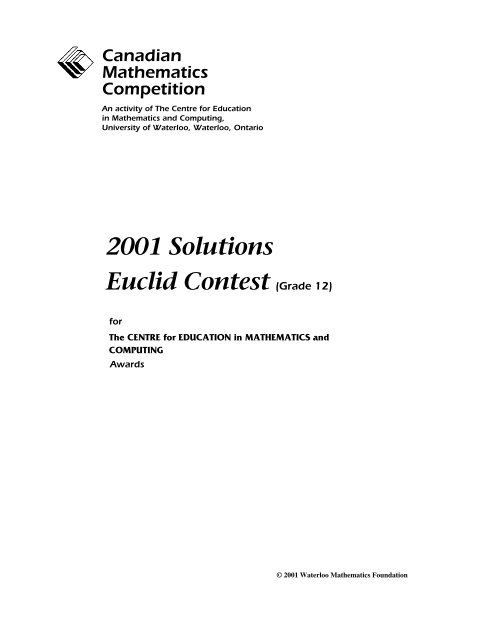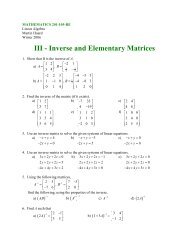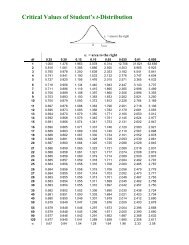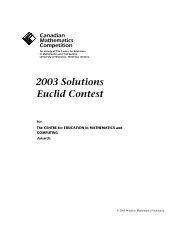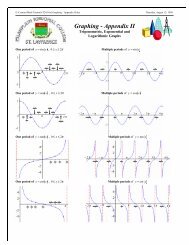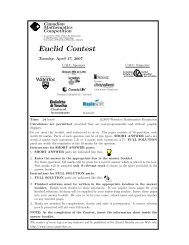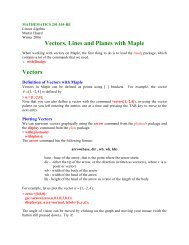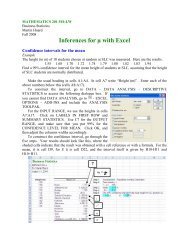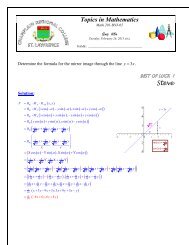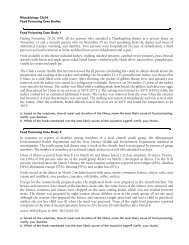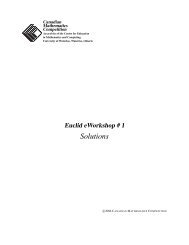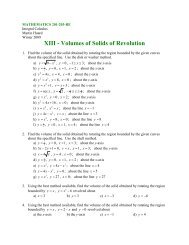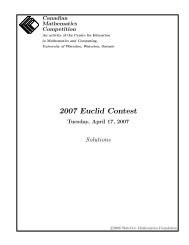Euclid Contest Solutions 2001 - CEMC - University of Waterloo
Euclid Contest Solutions 2001 - CEMC - University of Waterloo
Euclid Contest Solutions 2001 - CEMC - University of Waterloo
You also want an ePaper? Increase the reach of your titles
YUMPU automatically turns print PDFs into web optimized ePapers that Google loves.
Canadian<br />
Mathematics<br />
Competition<br />
An activity <strong>of</strong> The Centre for Education<br />
in Mathematics and Computing,<br />
<strong>University</strong> <strong>of</strong> <strong>Waterloo</strong>, <strong>Waterloo</strong>, Ontario<br />
<strong>2001</strong> <strong>Solutions</strong><br />
<strong>Euclid</strong> <strong>Contest</strong> (Grade 12)<br />
for<br />
The CENTRE for EDUCATION in MATHEMATICS and<br />
COMPUTING<br />
Awards<br />
© <strong>2001</strong> <strong>Waterloo</strong> Mathematics Foundation
<strong>2001</strong> EUCLID SOLUTIONS 2<br />
2<br />
( ) = ?<br />
1. (a) What are the values <strong>of</strong> x such that 2x – 3 9<br />
Solution 1<br />
2<br />
( ) =<br />
2<br />
2x<br />
– 3 9<br />
( ) =<br />
2x<br />
– 3 – 9 0<br />
2x– 3– 3 ( 2x–<br />
3 3)= 0 [by difference <strong>of</strong> squares]<br />
( ) +<br />
( x–<br />
)( x)=<br />
2 6 2 0<br />
so x = 3 or x = 0.<br />
Solution 2<br />
2<br />
( 2x – 3) = 9<br />
2x – 3= 3 or 2x – 3=<br />
– 3<br />
Therefore x = 3 or x = 0.<br />
Solution 3<br />
2<br />
4x<br />
– 12x+ 9=<br />
9<br />
2<br />
4x<br />
– 12x<br />
= 0<br />
4xx<br />
( – 3)=<br />
0<br />
Therefore x = 0 or x = 3.<br />
(b) If f( x)= x 2 – 3x– 5, what are the values <strong>of</strong> k such that f( k)= k?<br />
Solution<br />
2<br />
If f( k)= k, then k – 3k– 5=<br />
k<br />
2<br />
k – 4k–<br />
5=<br />
0<br />
( k–<br />
5) ( k+<br />
1)=<br />
0<br />
so k = 5 or k = –1.<br />
(c)<br />
Determine all x,<br />
y<br />
( ) such that x y<br />
2 2<br />
+ = 25 and x– y= 1.<br />
Solution 1 (Algebraic)<br />
Since x– y= 1, then x = y+1 (or y= x–1).<br />
2 2<br />
So since x + y = 25, then<br />
2 2<br />
2 2<br />
( y+<br />
1) + y = 25 or x + ( x–<br />
1) = 25
<strong>2001</strong> EUCLID SOLUTIONS 3<br />
2 2<br />
y + 2y+ 1+ y = 25<br />
2<br />
2y<br />
+ 2y–<br />
24 = 0<br />
2<br />
2 2<br />
x + x – 2x+ 1=<br />
25<br />
2x<br />
– 2x–<br />
24 = 0<br />
y + y–<br />
12 = 0<br />
x – x–<br />
12 = 0<br />
( y+<br />
4)( y–<br />
3)=<br />
0<br />
y = – 43 ,<br />
( x–<br />
4) ( x+<br />
3)=<br />
0<br />
x = 4,–<br />
3<br />
and using x = y+1, and using y= x–1,<br />
we get x = – 34. ,<br />
we get y = 3,– 4.<br />
So the solutions are x, y – 3,– 4 , 4,<br />
3 .<br />
( )= ( ) ( )<br />
2<br />
2<br />
Solution 2 (Graphical)<br />
2 2<br />
Placing each <strong>of</strong> x + y = 25 and x– y= 1 on a<br />
grid we have the diagram at the right.<br />
(0, 5)<br />
y<br />
x – y = 1<br />
(4, 3)<br />
(0, –1)<br />
(1, 0)<br />
(5, 0)<br />
x<br />
(– 3, – 4)<br />
x 2 + y 2 = 25<br />
( )= ( )<br />
Therefore, the solutions are x, y – 3, – 4 , (4, 3).<br />
2. (a) The vertex <strong>of</strong> the parabola y= ( x–<br />
b) + b+<br />
h<br />
2<br />
has coordinates( 25 , ). What is the value <strong>of</strong> h?<br />
Solution<br />
Since the x-coordinate <strong>of</strong> the vertex is 2, then b = 2.<br />
Since the y-coordinate <strong>of</strong> the vertex is 5, then b+ h=5. Since b = 2, then h = 3.<br />
(b) In the isosceles triangle ABC, AB = AC and ∠ BAC = 40 ° .<br />
Point P is on AC such that BP is the bisector <strong>of</strong> ∠ ABC.<br />
Similarly, Q is on AB such that CQ bisects ∠ ACB. What is the<br />
size <strong>of</strong> ∠ APB, in degrees?<br />
Q<br />
A<br />
P<br />
B<br />
C
<strong>2001</strong> EUCLID SOLUTIONS 4<br />
Solution<br />
Let ∠ ABC = 2 x°<br />
. Since ∆ ABC is isosceles, then ∠ ACB = 2 x°<br />
.<br />
Since BP bisects ∠ ABC, ∠ ABP =∠ CBP = x ° .<br />
Similarly, ∠ ACQ =∠ BCQ = x ° .<br />
The angles in ∆ ABC add to 180°, so<br />
40°+ 2x°+ 2x°= 180°<br />
x = 35.<br />
In ∆ APB, the angles add to 180°, so<br />
40°+ 35°+∠ APB = 180°<br />
∠ APB = 105°<br />
.<br />
B<br />
Q<br />
A<br />
40°<br />
x° x°<br />
x°<br />
x°<br />
P<br />
C<br />
(c)<br />
In the diagram, AB = 300, PQ = 20, and QR = 100 . Also,<br />
QR is parallel to AC. Determine the length <strong>of</strong> BC, to the<br />
nearest integer.<br />
A<br />
Q<br />
P<br />
R<br />
B<br />
C<br />
Solution 1<br />
Since QR AC, ∠ QRP =∠ BAC = α (alternating angles).<br />
From ∆ RPQ, tan α= 1 5 .<br />
1 BC<br />
In ∆ ACB, since tan α= = , let BC<br />
5 AC = x and<br />
AC = 5 x. (This argument could also be made by just<br />
using the fact that ∆ RQP and ∆ ACB are similar.)<br />
2 2 2 90 000<br />
By Pythagoras, x + 25x<br />
= 300 , x = = ˙ 58. 83.<br />
Therefore BC = 59 m to the nearest metre.<br />
25<br />
A<br />
20<br />
α<br />
Q<br />
P<br />
100<br />
α<br />
R<br />
B<br />
C<br />
Solution 2<br />
Since QR AC, ∠ QRP =∠BAC (alternating angles).<br />
This means ∆ABC<br />
~ ∆RPQ<br />
(two equal angles).<br />
By Pythagoras,<br />
2 2 2<br />
PR = QP + QR<br />
A<br />
2 2<br />
PR = 100 + 20 = 10 400.<br />
Since ∆ABC<br />
~ ∆RPQ,<br />
20<br />
Q<br />
P<br />
100<br />
R<br />
B<br />
C
<strong>2001</strong> EUCLID SOLUTIONS 5<br />
BC PQ<br />
=<br />
AB RP<br />
AB⋅<br />
PQ<br />
BC =<br />
RP<br />
300 ⋅20<br />
=<br />
10 400<br />
= ˙ 58.<br />
83<br />
BC is 59 m (to the nearest metre).<br />
3. (a) In an increasing sequence <strong>of</strong> numbers with an odd number <strong>of</strong> terms, the difference between<br />
any two consecutive terms is a constant d, and the middle term is 302. When the last 4 terms<br />
are removed from the sequence, the middle term <strong>of</strong> the resulting sequence is 296. What is the<br />
value <strong>of</strong> d?<br />
Solution 1<br />
Let the number <strong>of</strong> terms in the sequence be 2k + 1.<br />
We label the terms a 1 , a 2 , ..., a 2k<br />
+ . 1<br />
The middle term here is a k+ 1 = 302.<br />
Since the difference between any two consecutive terms in this increasing sequence is d,<br />
am+ 1 – am<br />
= d for m= 12 , , ..., 2k.<br />
When the last 4 terms are removed, the last term is now a 2k–<br />
3 so the middle term is then<br />
a k–1 = 296. (When four terms are removed from the end, the middle term shifts two terms to<br />
the left.)<br />
Now 6= ak+ 1– ak– 1 =( ak+<br />
1– ak)+ ( ak – ak– 1)= d+ d = 2d.<br />
Therefore d = 3.<br />
Solution 2<br />
If the last four terms are removed from the sequence this results in 302 shifting 2 terms to the<br />
left in the new sequence meaning that 302 – 296 = 2d , d = 3.<br />
(b)<br />
There are two increasing sequences <strong>of</strong> five consecutive integers, each <strong>of</strong> which have the<br />
property that the sum <strong>of</strong> the squares <strong>of</strong> the first three integers in the sequence equals the sum<br />
<strong>of</strong> the squares <strong>of</strong> the last two. Determine these two sequences.<br />
Solution<br />
Let n be the smallest integer in one <strong>of</strong> these sequences.<br />
So we want to solve the equation n + ( n+1) + ( n+<br />
2) = ( n+<br />
3) + n+<br />
4<br />
given problem into an equation).<br />
2 2 2 2 2<br />
Thus n + n + 2n+ 1+ n + 4n+ 4= n + 6n+ 9+ n + 8n+<br />
16<br />
2 2 2 2 2<br />
( ) (translating the
<strong>2001</strong> EUCLID SOLUTIONS 6<br />
2<br />
n – 8n–<br />
20=<br />
0<br />
( n– 10) ( n+<br />
2)=<br />
0.<br />
So n = 10 or n = – 2.<br />
Therefore, the sequences are 10, 11, 12, 13, 14 and – 2, –1, 0, 1, 2.<br />
Verification<br />
2 2 2 2 2<br />
– 2 – 1 0 1 2 5<br />
2 2 2 2 2<br />
( ) + ( ) + = + = and 10 + 11 + 12 = 13 + 14 = 365<br />
4. (a) If f()=<br />
t sin<br />
⎛<br />
πt–<br />
⎝<br />
minimum value?<br />
π⎞<br />
2 ⎠<br />
, what is the smallest positive value <strong>of</strong> t at which f() t attains its<br />
Solution 1<br />
π π<br />
2 2<br />
Since t > 0, πt – > – . So sin πt<br />
–<br />
π 3π<br />
πt<br />
– =<br />
2 2<br />
t = 2.<br />
( ) first attains its minimum value when<br />
π<br />
2<br />
Solution 2<br />
Rewriting f t<br />
Thus f t<br />
at the right.<br />
Thus f t<br />
1<br />
()= sin ( – )<br />
() as, f t π t<br />
() has a period 2 2<br />
[ 2 ]<br />
.<br />
π<br />
= and appears in the diagram<br />
π<br />
() attains its minimum at t = 2 . Note that f()<br />
t<br />
attains a minimum value at t = 0 but since t > 0, the<br />
required answer is t = 2 .<br />
f (t)<br />
1<br />
1<br />
2<br />
2<br />
5<br />
2<br />
t
<strong>2001</strong> EUCLID SOLUTIONS 7<br />
(b) In the diagram, ∠ ABF = 41 ° , ∠ CBF = 59 ° , DE is<br />
parallel to BF, and EF = 25. If AE = EC , determine the<br />
length <strong>of</strong> AE , to 2 decimal places.<br />
A<br />
B<br />
D<br />
41°<br />
59°<br />
F<br />
25<br />
E<br />
C<br />
Solution<br />
Let the length <strong>of</strong> AE = EC be x.<br />
Then AF = x – 25.<br />
In, ∆ BCF , x + 25<br />
= tan ( 59°<br />
).<br />
BF<br />
A<br />
x – 25<br />
In ∆ ABF, x – 25<br />
= tan ( 41°<br />
).<br />
BF<br />
Solving for BF in these two equations and equating,<br />
x+<br />
25 x<br />
BF =<br />
° = – 25<br />
tan 59 tan 41°<br />
so ( tan 41°<br />
)( x+<br />
25)= ( tan 59°<br />
)( x–<br />
25)<br />
25( tan 59°+ tan 41°<br />
)= x( tan 59° – tan 41°<br />
)<br />
25( tan 59°+ tan 41°<br />
)<br />
x =<br />
tan 59° – tan 41°<br />
x = ˙ 79. 67.<br />
Therefore the length <strong>of</strong> AE is 79.67.<br />
B<br />
D<br />
41°<br />
59°<br />
F<br />
25<br />
E<br />
x<br />
C<br />
2 2<br />
5. (a) Determine all integer values <strong>of</strong> x such that ( x – 3) ( x + 5)< 0.<br />
Solution<br />
Since x 2 ≥ 0 for all x, x 2 2 2<br />
+ 5> 0. Since ( x – 3) ( x + 5)< 0, x 2 – 3< 0, so x 2 < 3 or<br />
– 3 < x < 3. Thus x = – 101. , ,<br />
(b)<br />
At present, the sum <strong>of</strong> the ages <strong>of</strong> a husband and wife, P, is six times the sum <strong>of</strong> the ages <strong>of</strong><br />
their children, C. Two years ago, the sum <strong>of</strong> the ages <strong>of</strong> the husband and wife was ten times
<strong>2001</strong> EUCLID SOLUTIONS 8<br />
the sum <strong>of</strong> the ages <strong>of</strong> the same children. Six years from now, it will be three times the sum<br />
<strong>of</strong> the ages <strong>of</strong> the same children. Determine the number <strong>of</strong> children.<br />
Solution<br />
Let n be the number <strong>of</strong> children.<br />
At the present, P= 6 C, where P and C are as given. (1)<br />
Two years ago, the sum <strong>of</strong> the ages <strong>of</strong> the husband and wife was P – 4, since they were each<br />
two years younger.<br />
Similarly, the sum <strong>of</strong> the ages <strong>of</strong> the children was C– n( 2) (n is the number <strong>of</strong> children).<br />
So two years ago, P– 4= 10( C–<br />
2n) (2), from the given condition.<br />
Similarly, six years from now, P+ 12 = 3( C+<br />
6 n)<br />
(3), from the given condition.<br />
We want to solve for n.<br />
Substituting (1) into each <strong>of</strong> (2) and (3),<br />
6C– 4 = 10( C–<br />
2n) or 20n– 4C= 4 or 5n– C=<br />
1<br />
6C+ 12= 3( C+<br />
6n) or – 18n+ 3C= – 12 or – 6n+ C=<br />
– 4<br />
Adding these two equations, – n = – 3, so n = 3.<br />
Therefore, there were three children.<br />
6. (a) Four teams, A, B, C, and D, competed in<br />
a field hockey tournament. Three<br />
Medal Gold Silver Bronze<br />
coaches predicted who would win the Team<br />
Gold, Silver and Bronze medals:<br />
• Coach 1 predicted Gold for A, Silver for B, and Bronze for C,<br />
• Coach 2 predicted Gold for B, Silver for C, and Bronze for D,<br />
• Coach 3 predicted Gold for C, Silver for A, and Bronze for D.<br />
Each coach predicted exactly one medal winner correctly. Complete the table in the answer<br />
booklet to show which team won which medal.<br />
Solution<br />
If A wins gold, then Coach 1 has one right. For Coach 3 to get one right, D must win bronze,<br />
since A cannot win silver. Since D wins bronze, Coach 2 gets one right. So C can’t win<br />
silver, so B does which means Coach 1 has two right, which can’t happen. So A doesn’t win<br />
gold.<br />
If B wins gold, then Coach 2 has one right. For Coach 1 to get one right, C wins bronze, as B<br />
can’t win silver.<br />
For Coach 3 to get one right, A wins silver.<br />
So Gold to B, Silver to A and Bronze to C satisfies the conditions.
<strong>2001</strong> EUCLID SOLUTIONS 9<br />
(b) In triangle ABC, AB = BC =25 and AC = 30. The<br />
circle with diameter BC intersects AB at X and AC at<br />
Y. Determine the length <strong>of</strong> XY .<br />
X<br />
B<br />
A Y C<br />
Solution 1<br />
Join BY . Since BC is a diameter, then ∠ BYC = 90 ° .<br />
Since AB = BC, ∆ ABC is isosceles and BY is an<br />
altitude in ∆ ABC , then AY = YC =15.<br />
Let ∠ BAC = θ.<br />
Since ∆ ABC is isosceles, ∠ BCA = θ.<br />
Since BCYX is cyclic, ∠ BXY = 180 – θ and so<br />
∠ AXY = θ .<br />
Thus ∆ AXY is isosceles and so XY = AY =15.<br />
Therefore XY = 15.<br />
θ<br />
θ<br />
B<br />
X 25<br />
15<br />
A 15 Y C<br />
θ<br />
Solution 2<br />
Join BY . ∠ BYC = 90 ° since it is inscribed in a<br />
semicircle.<br />
∆ BAC is isosceles, so altitude BY bisects the<br />
base.<br />
2 2<br />
Therefore BY = 25 – 15 = 20.<br />
Join CX . ∠ CXB = 90 ° since it is also inscribed in<br />
a semicircle.<br />
The area <strong>of</strong> ∆ ABC is<br />
1<br />
( AC)<br />
( BY)<br />
= 1 ( AB)<br />
( CX)<br />
2 2<br />
1<br />
( 2 30)<br />
( 20)<br />
= 1 ( 2 25)<br />
( CX)<br />
X<br />
B<br />
7 20 25<br />
24<br />
15<br />
A 15 Y C<br />
CX = 600 = 24.<br />
25<br />
BY 20 4<br />
From ∆ ABY we conclude that cos ∠ ABY = = =<br />
AB 25 5 .<br />
2 2 2<br />
In ∆ BXY , applying the Law <strong>of</strong> Cosines we get ( XY) = ( BX) + ( BY) – 2( BX)( BY) cos ∠ XBY.<br />
Now (by Pythagoras ∆ BXC),
<strong>2001</strong> EUCLID SOLUTIONS 10<br />
2 2 2<br />
BX = BC – CX<br />
2 2<br />
= 25 – 24<br />
= 49<br />
BX = 7.<br />
Therefore XY 2 = 7 2 + 20 2 – 2( 7)( 20)<br />
4 5<br />
= 49 + 400 – 224<br />
= 225.<br />
Therefore XY = 15.<br />
7. (a) What is the value <strong>of</strong> x such that log2( log 2( 2x<br />
– 2)<br />
)= 2?<br />
Solution<br />
log ( log ( 2x<br />
– 2)<br />
)= 2<br />
2 2<br />
log ( 2x<br />
– 2)=<br />
2<br />
2<br />
2x<br />
– 2=<br />
2<br />
2x<br />
– 2=<br />
2<br />
2<br />
2<br />
( 2 )<br />
4<br />
2x<br />
– 2=<br />
16<br />
2x<br />
= 18<br />
x = 9<br />
(b)<br />
() ()=<br />
kx<br />
Let f( x)= 2 + 9, where k is a real number. If f 3 : f 6 1: 3, determine the value <strong>of</strong><br />
f 9 – f 3 .<br />
( ) ( )<br />
Solution<br />
From the given condition,<br />
3k<br />
f () 3 2 9 1<br />
6k<br />
f ( 6) = +<br />
2 + 9<br />
= 3<br />
3k<br />
6k<br />
32 ( + 9)= 2 + 9<br />
6k<br />
3k<br />
= ( )<br />
0 2 – 3 2 – 18.<br />
k<br />
We treat this as a quadratic equation in the variable x = 2 3 , so<br />
2<br />
0=<br />
x – 3x–<br />
18<br />
0= ( x– 6) ( x+<br />
3)<br />
.<br />
Therefore, 2 3k = 6 or 2 3k = – 3. Since 2 a > 0 for any a, then 2 3k ≠ – 3.<br />
So 2 3k = 6. We could solve for k here, but this is unnecessary.
<strong>2001</strong> EUCLID SOLUTIONS 11<br />
We calculate f<br />
Therefore f<br />
– (<br />
9k<br />
)–( 3k<br />
+ )<br />
9k<br />
3k<br />
( ) ( )= +<br />
9 f 3 2 9 2 9<br />
( ) ( )=<br />
= 2 – 2<br />
3k<br />
= ( )<br />
9 – f 3 210.<br />
3<br />
2 – 2<br />
3<br />
= 6 – 6<br />
= 210.<br />
3k<br />
8. (a) On the grid provided in the answer booklet, sketch y= x<br />
2 – 4 and y= 2 x .<br />
Solution<br />
y<br />
y = 2 x<br />
6<br />
4<br />
2<br />
– 6<br />
– 4 – 2 0 2 4<br />
6<br />
x<br />
– 2<br />
y = x 2 – 4<br />
– 4<br />
– 6<br />
(b) Determine, with justification, all values <strong>of</strong> k for which y= x<br />
– 4 and y= 2 x + k do not<br />
intersect.<br />
Solution<br />
Since each <strong>of</strong> these two graphs is symmetric about the y-axis (i.e. both are even functions),<br />
then we only need to find k so that there are no points <strong>of</strong> intersection with x ≥ 0.<br />
So let x ≥ 0 and consider the intersection between y= 2 x+<br />
k and y= x<br />
2 – 4 .<br />
2<br />
Equating, we have, 2x+ k = x – 4.<br />
2<br />
Rearranging, we want x – 2x– ( k+<br />
4)= 0 to have no solutions.
<strong>2001</strong> EUCLID SOLUTIONS 12<br />
For no solutions, the discriminant is negative, i.e.<br />
20 + 4k<br />
< 0<br />
4k<br />
< – 20<br />
k < – 5.<br />
So y= x<br />
2 – 4 and y= 2 x + k have no intersection points when k < – 5.<br />
(c) State the values <strong>of</strong> k for which y= x<br />
– 4 and y= 2 x + k intersect in exactly two points.<br />
(Justification is not required.)<br />
Solution Analysing Graphs<br />
For k < – 5, there are no points <strong>of</strong><br />
intersection. When k = – 5, the<br />
graph with equation y= 2 x + k is<br />
tangent to the graph with equation<br />
y= x<br />
2 – 4 for both x ≥ 0 and x ≤ 0.<br />
So k = – 5 is one possibility for two<br />
intersection points.<br />
y<br />
6<br />
4<br />
2<br />
y = x 2 – 4<br />
y = 2 x<br />
– 5<br />
– 6<br />
– 4 – 2 0 2 4<br />
6<br />
x<br />
– 2<br />
– 4<br />
– 6
<strong>2001</strong> EUCLID SOLUTIONS 13<br />
For – 5< k < – 4 a typical graph<br />
appears on the right.<br />
i.e. for – 5< k < – 4, there will be 4<br />
points <strong>of</strong> intersection.<br />
y<br />
6<br />
4<br />
2<br />
– 6<br />
– 4 – 2 0 2 4<br />
6<br />
x<br />
– 2<br />
– 4<br />
– 6<br />
When k = – 4, a typical graph<br />
appears on the right.<br />
y<br />
6<br />
4<br />
2<br />
– 6<br />
– 4 – 2 0 2 4<br />
6<br />
x<br />
– 2<br />
– 4<br />
– 6
<strong>2001</strong> EUCLID SOLUTIONS 14<br />
So when k > – 4, there will only be<br />
two points <strong>of</strong> intersection, as the<br />
contact point at the cusp <strong>of</strong><br />
y= 2 x – 4 will be eliminated. An<br />
example where k = – 2 is shown.<br />
y<br />
6<br />
4<br />
y = 2 x<br />
+ k, k > – 4<br />
2<br />
– 6<br />
– 4 – 2 0 2 4<br />
6<br />
x<br />
– 2<br />
y = x 2 – 4<br />
– 4<br />
– 6<br />
So the possibility for exactly two distinct points <strong>of</strong> intersection are k = – 5, k > – 4.<br />
9. Triangle ABC is right-angled at B and has side lengths which<br />
are integers. A second triangle, PQR, is located inside ∆ ABC<br />
as shown, such that its sides are parallel to the sides <strong>of</strong> ∆ ABC<br />
and the distance between parallel lines is 2. Determine the<br />
side lengths <strong>of</strong> all possible triangles ABC, such that the area <strong>of</strong><br />
∆ ABC is 9 times that <strong>of</strong> ∆ PQR.<br />
A<br />
P<br />
2<br />
2<br />
Q R<br />
2<br />
B C<br />
Solution 1<br />
Let the sides <strong>of</strong> ∆ ABC be AB = c , BC = a, AC = b, a, b, c are all integers.<br />
Since the sides <strong>of</strong> ∆ PQR are all parallel to the sides <strong>of</strong> ∆ ABC , then ∆ ABC is similar to ∆ PQR.<br />
Now the ratio <strong>of</strong> areas <strong>of</strong> ∆ ABC to ∆ PQR is 9= 3 2 to 1, so the ratio <strong>of</strong> side lengths will be 3 to 1.<br />
So the sides <strong>of</strong> ∆ PQR are PQ = c<br />
3<br />
, QR = a<br />
3<br />
, PR = b<br />
3<br />
.
<strong>2001</strong> EUCLID SOLUTIONS 15<br />
So we can label the diagram as indicated.<br />
We join the corresponding vertices <strong>of</strong> the two triangles as<br />
Area <strong>of</strong> trapezoid BQRC<br />
Area <strong>of</strong> trapezoid CRPA<br />
Area <strong>of</strong> trapezoid APQB<br />
+ Area <strong>of</strong> ∆PQR<br />
Area <strong>of</strong> ∆ ABC.<br />
Doing so gives,<br />
2<br />
⎛ 2 a<br />
⎞<br />
2 2 2 2 ac ac<br />
b c<br />
⎝ 3 ⎠ + ⎛ ⎞<br />
⎝ 3 ⎠ + ⎛ ⎞<br />
⎝ 3 ⎠ + 18 = 72<br />
Or upon simplifying ac = 3a + 3b + 3 c (Note that this<br />
relationship can be derived in a variety <strong>of</strong> ways.)<br />
ac = 3c + 3b + 3a<br />
ac – 3c – 3a = 3b<br />
2 2<br />
ac – 3c – 3a 3 a c<br />
ac 2 2 + 9c 2 + 9a 2 6ac 2 6ac 2 + 18ac= 9 a 2 + c<br />
2<br />
c<br />
A<br />
c<br />
3<br />
P<br />
b<br />
3<br />
Q a R<br />
3<br />
B a C<br />
2 2 )<br />
= + (since b= a + c<br />
– – (squaring both sides)<br />
( )<br />
ac( ac – 6c – 6a<br />
+ 18)=<br />
0<br />
ac – 6c – 6a<br />
+ 18 = 0<br />
(as ac ≠ 0 )<br />
ca ( – 6)=<br />
6a–<br />
18<br />
6a<br />
– 18<br />
c =<br />
a – 6<br />
18<br />
c = 6 +<br />
a – 6<br />
.<br />
Since a is a side <strong>of</strong> a triangle, a > 0. We are now looking for positive integer values such that<br />
18<br />
is also an integer.<br />
a – 6<br />
The only possible values for a are 3, 7, 8, 9, 12, 15 and 24.<br />
Tabulating the possibilities and calculating values for b and c gives,<br />
a 3 7 8 9 12 15 24<br />
c 0 24 15 12 9 8 7<br />
b – 25 17 15 15 17 25<br />
Thus the only possibilities for the triangle are ( 72425 , , ), 8157 , ,<br />
Solution 2<br />
The two triangles are similar with areas in the ratio 1:9.<br />
Therefore the sides are in the ratio 1:3.<br />
Let a= BC, b= CA, c= BA.<br />
( ) and 91215 , ,<br />
( ).<br />
b
<strong>2001</strong> EUCLID SOLUTIONS 16<br />
Then a = PQ<br />
3 , b = QR<br />
3 , c = PR<br />
3 .<br />
Locate points K, L on BC; M, N on CA; and T, S on AB as<br />
shown.<br />
BC = BK + KL + LC<br />
a= BK + a + 2<br />
3<br />
a<br />
K<br />
L<br />
B<br />
T<br />
P<br />
2<br />
2<br />
Q 2 R<br />
c<br />
S<br />
Therefore BK = 2 a<br />
3<br />
In a similar way, AN<br />
Now ∆BKP<br />
– 2.<br />
= 2 b – 2.<br />
3<br />
≅ ∆BTP<br />
and ∆ANR<br />
≅ ∆<br />
Therefore BT = BK = 2 a<br />
3<br />
Now, AB = AS + ST + BT<br />
2<br />
3<br />
2 c<br />
3 3<br />
c= b– 2+ + a–<br />
2<br />
2<br />
3<br />
2<br />
3<br />
c= b+<br />
a–<br />
4<br />
c= b+<br />
a–<br />
6<br />
b= c+( 6 – a)<br />
.<br />
By Pythagoras, a + b = c<br />
ASR, both by HL.<br />
– 2 and AS = AN = 2 b<br />
3<br />
2<br />
3<br />
2 2 2<br />
a 2 + [c + (6 – a)]2 = c 2<br />
a 2 + c 2 + 2c(6 – a) + (6 – a)2 = c 2<br />
a 2 + (6 – a) 2 = – 2c(6 – a)<br />
2a 2 – 12a + 36 = 2c(a – 6)<br />
a 2 – 6a + 18 = c(a – 6)<br />
– 2.<br />
C M N<br />
b<br />
A<br />
2<br />
a – 6a+<br />
18<br />
c =<br />
a – 6<br />
aa<br />
c = ( – 6 )+ 18<br />
a – 6<br />
18<br />
c= a+<br />
a – 6<br />
.<br />
Since a and c are integers, a – 6 is a divisor <strong>of</strong> 18.<br />
Also since b< c and b= c+( 6 – a)<br />
, we conclude that 6– a < 0 so a – 6> 0.<br />
Thus a – 6 can be 1, 2, 3, 6, 9, 18.<br />
The values <strong>of</strong> a are: 7, 8, 9, 12, 15, 24.<br />
Matching values for c: 25, 17, 15, 15, 17, 25<br />
Matching values for b: 24, 15, 12, 9, 8, 7
<strong>2001</strong> EUCLID SOLUTIONS 17<br />
The distinct triangles are (7, 24, 25), (8, 15, 17) and (9, 12, 15).<br />
10. Points P and Q are located inside the square ABCD such that<br />
DP is parallel to QB and DP = QB = PQ. Determine the<br />
minimum possible value <strong>of</strong> ∠ ADP .<br />
A B<br />
P<br />
Q<br />
D C<br />
Solution 1<br />
Placing the information on the coordinate axes, the diagram<br />
is indicated to the right.<br />
We note that P has coordinates ( ab , ).<br />
By symmetry (or congruency) we can label lengths a and b<br />
as shown. Thus Q has coordinates ( 2– a, 2–<br />
b).<br />
2 2 2 2<br />
Since PD = PQ, a + b =( 2– 2a) + ( 2–<br />
2b)<br />
or, 3a 2 + 3b 2 – 8a–<br />
8b+ 8=<br />
0<br />
4 2 4 2 8<br />
( a– b–<br />
3) + ( 3) =<br />
9<br />
P is on a circle with centre O 4 4<br />
( ,<br />
3 3) with r = 2 2 .<br />
3<br />
The minimum angle for θ occurs when DP is tangent to the<br />
circle.<br />
A(0, 2) B(2, 2)<br />
aP(a, b)<br />
b θ<br />
a<br />
θ b Q(2 – a, 2 – b)<br />
D(0, 0) C(2, 0)<br />
So we have the diagram noted to the right.<br />
Since OD makes an angle <strong>of</strong> 45° with the x -axis then<br />
∠ PDO = 45 – θ and OD = 4 2 .<br />
3<br />
2<br />
2 1<br />
Therefore sin 45 –<br />
3<br />
( θ)= = which means 45° – θ = 30°<br />
or<br />
2 2<br />
θ= 15 ° .<br />
Thus the minimum value for θ is 15°.<br />
4<br />
3<br />
θ<br />
D<br />
P<br />
2<br />
3<br />
45 – θ<br />
2<br />
O 4 3 , 4 3<br />
( )<br />
Solution 2<br />
Let AB = BC = CD = DA =1.<br />
Join D to B. Let ∠ ADP = θ. Therefore, ∠ PDB = 45 – θ.<br />
Let PD = a and PB = b and PQ = a . 2
<strong>2001</strong> EUCLID SOLUTIONS 18<br />
We now establish a relationship between a and b.<br />
2 2<br />
In ∆ PDB, b a 2– 2 a 2 cos 45– θ<br />
= + ( )( ) ( )<br />
a<br />
or, cos ( 45 – θ)=<br />
2 2<br />
– b + 2<br />
2 2a<br />
(1)<br />
A B<br />
θ<br />
a<br />
P<br />
45 – θ<br />
a<br />
2<br />
R<br />
b<br />
Q<br />
In ∆ PDR,<br />
⎛ a⎞<br />
⎝ 2⎠<br />
a +<br />
or, cos 45 – θ<br />
2<br />
( )=<br />
a 2<br />
Comparing (1) and (2) gives, a<br />
Simplifying this, a<br />
or,<br />
2<br />
2<br />
2 2 2<br />
= a + ⎛ 2a<br />
45<br />
⎝ ⎜ ⎞<br />
⎟ – cos ( – θ)<br />
2 ⎠ 2<br />
b<br />
Now cos ( 45 – θ)=<br />
3<br />
4<br />
2 1<br />
2 2<br />
2<br />
+ 2b<br />
= 2<br />
a<br />
2<br />
2 a<br />
= – .<br />
2<br />
2<br />
(2)<br />
– b + 2 a +<br />
=<br />
4 2 .<br />
2 2a<br />
a 2<br />
2 2<br />
⎛ 2 – a<br />
+ 2 – ⎜<br />
⎝ 2<br />
2a<br />
2<br />
2 ⎛<br />
Now considering 3a<br />
+ , we know ⎜ 3a<br />
–<br />
a ⎝<br />
2<br />
or, 3a<br />
+ ≥ 2 6.<br />
a<br />
1<br />
Thus, cos 45 –<br />
4 2 2 6 3<br />
( θ)≥ ( )=<br />
2<br />
3<br />
cos ( 45 – θ)≥ .<br />
2<br />
cos 45 – θ<br />
2<br />
⎞<br />
⎟<br />
⎠<br />
3<br />
2 1<br />
1<br />
4 2 3 2<br />
=<br />
⎛<br />
a +<br />
⎞<br />
⎝ a ⎠<br />
.<br />
2 ⎞<br />
⎟<br />
a ⎠<br />
( ) has a minimum value for 45 30<br />
2<br />
≥ 0<br />
° – θ = ° or θ= 15 ° .<br />
Solution 3<br />
Join BD. Let BD meet PQ at M. Let ∠ ADP = θ.<br />
By interior alternate angles, ∠ P=∠Q and<br />
∠ PDM =∠QBM.<br />
Thus ∆PDM<br />
≅ ∆QBM<br />
by A.S.A., so PM = QM and<br />
DM = BM.<br />
So M is the midpoint <strong>of</strong> BD and the centre <strong>of</strong> the square.<br />
D C
<strong>2001</strong> EUCLID SOLUTIONS 19<br />
Without loss <strong>of</strong> generality, let PM = 1. Then PD = 2.<br />
Since θ+ α= 45 ° (see diagram), θ will be minimized when<br />
α is maximized.<br />
A B<br />
P<br />
1<br />
2 M<br />
θ<br />
Q<br />
α<br />
D C<br />
Consider ∆ PMD .<br />
Using the sine law, sin α sin ( ∠ PMD )<br />
=<br />
.<br />
1 2<br />
To maximize α, we maximize sin α.<br />
sin ( ∠ PMD)<br />
But sin α=<br />
, so it is maximized when sin ( ∠ PMD)=<br />
1.<br />
2<br />
In this case, sin α= 1 , so α= °<br />
2 30 .<br />
Therefore, θ= 45° – 30°= 15°<br />
, and so the minimum value <strong>of</strong> θ is 15°.<br />
Solution 4<br />
We place the diagram on a coordinate grid, with D( 00 , ),<br />
C( 10 , ), B( 01 , ), A( 11 , ).<br />
Let PD = PQ = QB = a , and ∠ ADP = θ.<br />
Drop a perpendicular from P to AD, meeting AD at X.<br />
Then PX = a sin θ, DX = a cos θ.<br />
Therefore the coordinates <strong>of</strong> P are ( asin θ, acos<br />
θ).<br />
Since PD BQ, then ∠ QBC = θ.<br />
So by a similar argument (or by using the fact that PQ are<br />
symmetric through the centre <strong>of</strong> the square), the coordinates<br />
<strong>of</strong> Q are ( 1– asin θ, 1+<br />
acos<br />
θ).<br />
A(0, 1) B(1, 1)<br />
P<br />
X<br />
a<br />
a<br />
a Q<br />
D(0, 0) C(1, 0)<br />
( ) =<br />
( ) 2 + ( ) 2 =<br />
2<br />
+ sin θ+ cos θ– ( sin θ+<br />
cos θ)<br />
=<br />
Now PQ<br />
2 a<br />
2 , so 1 – 2 asin θ 1 – 2 acos<br />
θ a<br />
2 2 2 2 2<br />
2 4a 4a 4a a
<strong>2001</strong> EUCLID SOLUTIONS 20<br />
Now ⎛a – 2 ⎞<br />
⎝ 3 ⎠<br />
a<br />
2 2<br />
3<br />
2<br />
2<br />
3<br />
2<br />
2 2<br />
2+ 4a – a = 4a<br />
sin θ+<br />
cos θ<br />
≥ 0<br />
– 2a<br />
+ ≥0<br />
3a<br />
– 2a<br />
6 + 2≥0<br />
2<br />
3a<br />
+ 2 ≥ 2a<br />
6<br />
2<br />
3a<br />
+ 2 ≥<br />
4 2a<br />
3<br />
2<br />
2<br />
2+<br />
3a<br />
4a<br />
2+<br />
3a<br />
4 2a<br />
2+<br />
3a<br />
4 2a<br />
and equality occurs when a = 2 3 .<br />
2<br />
2<br />
( )<br />
= sin θ+<br />
cos θ<br />
1 1<br />
= sin θ+ cos θ = cos ( 45°<br />
) sin θ+ sin ( 45°<br />
) cos θ<br />
2 2<br />
( )<br />
= sin θ + 45°<br />
3<br />
So sin ( θ+ 45°<br />
)≥ and thus since 0 90<br />
2 °≤ θ ≤ ° , then θ+ 45°≥ 60 ° or θ≥ 15 ° .<br />
Therefore the minimum possible value <strong>of</strong> ∠ ADP is 15°.


